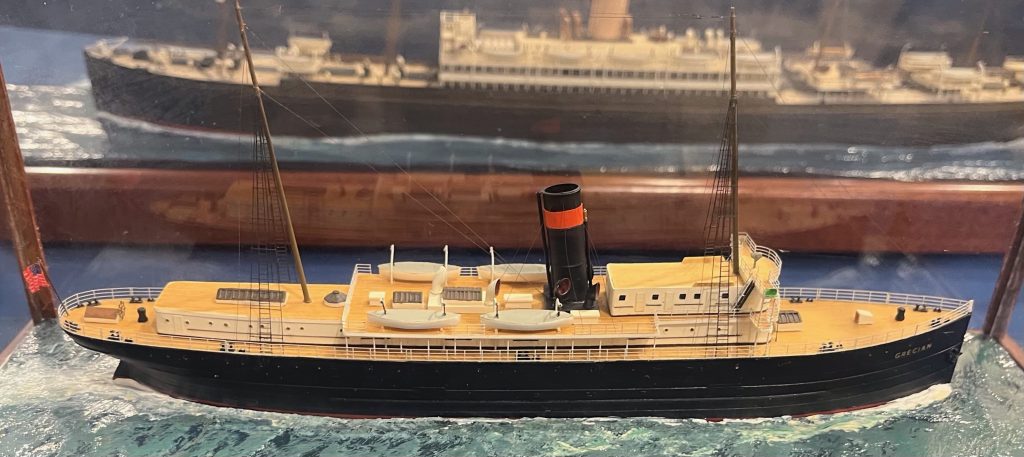Modeler’s Biography: Bob Fivehouse is a retired middle school teacher originally from New Jersey. He built ship models for the dioramas at Ellis Island in New York Harbor and the restoration of Montauk Point Lighthouse on Long Island, NY. He has also built models for the oceanographic ships of Lamont Earth Observatory for Columbia University. His models are in many private collections including the model of excursion steamer Queen Mary that is now owned by the secretary of the restoration project for that vessel. Bob generally models steamships in small scales (1:600 ~ 1:384).
Category Archives: Bob Fivehouse
Adriatic

Period Ship Sailed: 1907 – 1934
Type of Model: Scratch built with some photoetched parts
Build Time: About a year
Scale:
Description of build: The hull is carved from basswood with vellum overlays to represent the steel plating. The yellow line around the hull is painted vellum glued on. Decks are individual planks of holly. The deck houses are bass with paper overlays that have the windows cut into them. All the lifeboats are carved and painted with the davits made of brass rod. The masts are made out of skewers and the booms are of brass rod as are the deck stanchions. All the small fittings are made of wood, paper, and brass. The rails are photoetched commercially. The water is carved wood sealed with modeling paste and painted with acrylic paints. The flags are made of glassine paper.
Ship’s History: The Adriatic was completed by Harland and Wolff for the White Star Line in 1907. She was the fourth of the four giant ocean liners: Celtic, Cedric, and Baltic). The Adriatic was originally built for the Liverpool-New York service, she instead opened the new Southampton service for the White Star Line. In 1911, she went back to Liverpool service. She continued to serve until December 19, 1934, and proved among the most successful and profitable ocean liners ever built.
Campania

Period Ship Sailed: 1893 ~ 1918
Type of Model: Scratch build
Build Time: 10 months
Scale: 1:384 (~1” = 32’)
Description of build: The model is a solid waterline model constructed of wood, metal, and paper and is set in a sea of carved and painted wood in a mahogany case made by the builder.
Ship’s History: The Campania (British ~ 1893) was built by the Fairfield Shipbuilding & Engineering Co. for the Cunard Line. She was the largest and fastest ship in the world whenbuult and captured the Blue Ribbon in August 1894 with a voyage from Queenstown to Sandy Hook with an average speed of 21.49 knots. She was converted into an aircraft carrier during the first World War and was accidentally sunk in a collision with HMS Revenge during a storm at Scapa Flow on November 5, 1918 in the closing days of the war.
Grecian

Period Ship Sailed: Early 20th Century
Type of Model: Scratch built – waterline model
Build Time:
Scale:
Description of build: Hull is carved from basswood. Houses are basswood cores with Bristol board overlays. Decks are scribed holly. Funnel is brass tube. Boats are carved wood. Rigging is copper wire. Ware is carved painted with acrylic colors. Flag is glassine.
Ship’s History: Built in 1900 by Harland and Hollingworth, Wilmington, DE. Passenger and cargo steamer for Boston to Philadelphia service. 263’ between perpendiculars. 290’ overall. 2,827 gross tons. Two triple expansion engines ~ 2,820 ihp. Built for the Windsor line (Boston & Philadelphia SS Co.). Sunk in collision in dense fog off Block Island with City of Chattanooga (Sanannah Line) on May 27, 1932. Four passengers were killed.
Republic

Period Ship Sailed: 1903 – 1909
Type of Model: Scratch waterline
Build Time: About 8 months
Scale: 1” = 32’
Description of build: The model has a solid basswood hull and basswood deck houses with paper overlays for the cut-out windows. The decks are holly and the funnel is brass. The masts are wood turned to a pater. The boats are carved wood and the rigging is copper wire. The rails and stairs are photoetched brass. The model was built from plans drawn by Mr. Fivehouse based on the original rigging plan supplied by the builders.
Ship’s History: The Republic was built by Marland & Wolff in Belfast, Northern Ireland in 1903 as the Columbus for the Dominion Line service to Boston. Her main particulars were: Length = 570’ Breadth – 67.8’.
After only three voyages she was switched to the White Star Line and renamed Republic for the service from Boston and New York to the Mediterranean (usually Genoa, Italy). She was on such a voyage in 1909 when on January 23, after leaving New York, she was rammed in the port side amidship by the Italian line Florida in heavy fog just off the Nantucket lightship. Her wireless operator made the first known call for help using a radio and and number of ocean liners leaving New York. An attempt was made to tow her to shore but the next day she sank. She was the largest ship in the world to sink prior to the Titanic.
Her wreckage has been located in about 270’ of water. She was purported to have had gold on board worth 1.6 billion dollars by today’s (2023) value. The has not yet been recovered but more about the Republic can be found at Treasure of the RMS Republic
